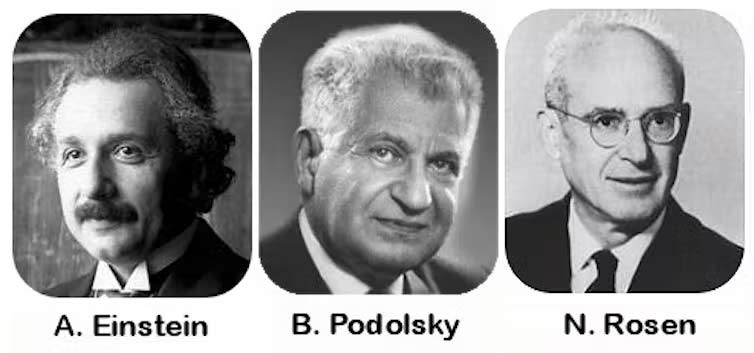05/10/2022
Published in
The Conversation
Javier Sánchez Cañizares
researcher from Institute for Culture and Society and group 'Science, Reason and Faith', University of Navarra.
award The history of the 2022 Nobel Prize in Physics, awarded to Alain Aspect, John Clauser and Anton Zelinger, dates back to 1935. In that year, Albert Einstein, Boris Podolsky and Nathan Rosen published a article that challenged quantum mechanics, criticizing its claims to be a complete theory.
The authors of article presented the following thought experiment (gedankenexperiment), of which Einstein was so fond.
Let us imagine a particle at rest disintegrating into two particles traveling with opposite velocities, each of them, in addition, endowed with an internal spin or spin. By the laws of conservation of angular momentum, the spin of each particle must also be opposite to that of the other. So, when we measure the spin of one of the particles, we will automatically know the spin of the other.

The standard interpretation of quantum mechanics understands that the properties of systems are not determined until a measurement is made. But then, when we measure the spin of one of the particles, we will also be instantaneously determining the spin of the particle traveling in the opposite direction. Is that reasonable considering that the particles could be an arbitrary distance apart? Such a possibility seemed to Einstein to be aspooky action at a distance, which he thought he had definitively defeated with his theory of relativity.
The article of 1935 proposed to get out of the quagmire by means of a quite logical proposal . In reality, the spin of each particle would already be determined when each of them emerged after the disintegration of the initial particle. We would not know their concrete values until we measure them because we do not know well the variables that, in the background, would be determining them.
Therefore, and this is the point core topic in the argumentation of Einstein and his colleagues, the measurement would not be creating something, but evidencing something that would already be determined in the two particles from the beginning. Quantum mechanics would be a theory provisional or incomplete because it would not be able to predict with accuracy the concrete value of the spin of each particle, but only give a probability of the measurement that would be obtained.
Are we discussing the sex of angels? Not at all. The story continues in 1964, when the Irish physicist John Bell presented a theoretical framework within which one could discriminate between Einstein's deterministic interpretation (which would be called "hidden variables") and the indeterministic interpretation of quantum mechanics (a physical quantity is not determined until a measurement is made).
Bell's inequalities, relations between the relevant quantities of the problem, must be fulfilled if the system devised by Einstein's side behaves deterministically, a la Einstein, thanks to these hidden variables; and they are not fulfilled (violated) if the system is really indeterminate, as the standard interpretation of quantum mechanics defends.
This is where our award-winning Aspect, Clausey and Zelinger come into play.
A blow to superdeterminism
A few years later, in 1969, John Clauser, together with Michael Horne, Abner Shimony and Richard Holt, generalized Bell's inequalities in a theoretical way, rigorously showing the statistical differences between local hidden variable models (bounded to the dimensions of the experiment) and the predictions of quantum mechanics.
At the beginning of the 1980s, after some attempts in other laboratories and by Clauser himself, Alain Aspect managed to demonstrate almost unequivocally that Bell's inequalities were violated using photons with entanglement of the subject proposed by Einstein: the possibility that local hidden variables were determining a priori the value of the measured quantities (in this case the polarization of the photons) was excluded.
Quantum mechanics won the day over the initial criticism of Einstein and co-workers.
Anton Zeilinger, for his part, is the experimental physicist who has most fruitfully studied the potential of the entanglement proposed by Einstein to develop the new science of quantum information, which is at the basis of encryption and quantum computing technologies.
But the interest of this award Nobel is not only practical. It offers us a core topic reading of natural processes that we have not yet sufficiently explored. Either quantum indeterminism is real (not a simple matter of imperfection of our knowledge), or else the only possible way out for determinists a la Einstein is that the hidden variables that determine the results are nonlocal, going so far as to conspire in the determination of the parameters of experiments that violate Bell's inequalities so that they occur in a superdeterministic way.
It would be worthwhile to add here, for the advocates of this hopeless deterministic interpretation, the recent experiments of Zeilinger and collaborators showing that such non-local hidden variables could only be affecting our current experiments for more than 7800 million years, taking their claimed influence practically back to the initial conditions of the universe at the Big Bang.
A hard blow for superdeterminism, no doubt, to which is added the media coup of the awarding of this award Nobel Prize in Physics.
This article was originally published in The Conversation. Read the original.
![]()
